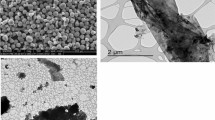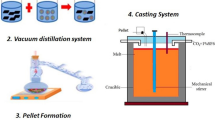Abstract
Nanocomposites including engineering materials that absorbed a great deal of scientist’s attention due to their excellent properties such as high strength and corrosion resistance. Optimization of development process and careful application of reinforcing nanoparticles are some approaches to improve mechanical properties. Thus, stir casting is considered as a dispersion method of reinforcement in melt. According to the properties of carbon-based particles, graphene nanoplates and carbon nanotubes were used as reinforcing particles in three different percentages including 0.01, 0.05, and 0.1 wt% in the initial alloy A356. Optimum conditions were determined by graphite stirrer with rotational speed of 500 rpm, in a continuous mode at 740 °C for 1 min. Elemental and phase analysis confirmed formation and distribution of reinforcing nanoparticles in a composite matrix. Tensile and compression strengths raised as a result of increment in reinforcement amounts. So that maximum increases of 28% and 55% were respectively reported for tensile and compression strengths using 0.1 wt% of graphene, compared with the sample containing minimum amount of reinforcement. Also 0.1 wt% carbon nanotube led to increase in nanocomposite hardness up to 88.4, indicating an improvement of 33%, compared with the reinforcement-free alloy. Increase of impact energy by 51% in the presence of 0.1 wt% carbon nanotubes has been the maximum enhancement in impact energy in the Charpy impact test, compared with the minimum amount of application in the same reinforcement.













Similar content being viewed by others
References
Jiang W, Chen X, Wang B, Fan Z, Wu H (2016) Effects of vibration frequency on microstructure, mechanical properties, and fracture behavior of A356 aluminum alloy obtained by expendable pattern shell casting. Int J Adv Manuf Technol 83(1-4):167–175
Jiang W, Fan Z, Chen X, Wang B, Wu H (2014) Combined effects of mechanical vibration and wall thickness on microstructure and mechanical properties of A356 aluminum alloy produced by expendable pattern shell casting. Mater Sci Eng A 619:228–237
Hashim J, Looney L, Hashmi M (1999) Metal matrix composites: production by the stir casting method. J Mater Process Technol 92:1–7
Hu Z, Tong G (2015) Laser sintered thin layer graphene and cubic boron nitride reinforced nickel matrix nanocomposites. Proc. SPIE 9673, AOPC 2015: Micro/Nano Optical Manufacturing Technologies; and Laser Processing and Rapid Prototyping Techniques, 967302. https://doi.org/10.1117/12.2196701
Ma J, Kang J, Huang T (2016) Novel application of ultrasonic cavitation for fabrication of TiN/Al composites. J Alloys Compd 661:176–181
Wang H, Geng H, Liu C (2012) The influence of SiO2 on the aluminum borate whisker reinforced aluminum phosphate wave-transparent materials. Procedia Eng 27:1222–1227
Rajkovic V, Bozic D, Jovanovic MT (2010) Effects of copper and Al2O3 particles on characteristics of Cu–Al2O3 composites. Mater Des 31(4):1962–1970
Yuan J, Zhang X, Li B, Wang X, Sun K (2017) Microstructure and tribological behavior of NiAl/WC composites fabricated by thermal explosion reaction at 800 °C. J Alloys Compd 693:70–75
Ma Z, Mishra RS, Tjong S (2002) High-temperature creep behavior of TiC particulate reinforced Ti–6Al–4V alloy composite. Acta Mater 50(17):4293–4302
Bakshi SR, Lahiri D, Agarwal A (2010) Carbon nanotube reinforced metal matrix composites-a review. Int Mater Rev 55(1):41–64
Li M, Che H, Liu X, Liang S, Xie H (2014) Highly enhanced mechanical properties in Cu matrix composites reinforced with graphene decorated metallic nanoparticles. J Mater Sci 49(10):3725–3731
Zhai W, Shi X, Yao J, Ibrahim AMM, Xu Z, Zhu Q, Xiao Y, Chen L, Zhang Q (2015) Investigation of mechanical and tribological behaviors of multilayer graphene reinforced Ni3Al matrix composites. Compos Part B 70:149–155
Hu Z, Tong G, Nian Q, Xu R, Saei M, Chen F, Chen C, Zhang M, Guo H, Xu J (2016) Laser sintered single layer graphene oxide reinforced titanium matrix nanocomposites. Compos Part B 93:352–359
Algul H, Tokur M, Ozcan S, Uysal M, Cetinkaya T, Akbulut H, Alp A (2015) The effect of graphene content and sliding speed on the wear mechanism of nickel–graphene nanocomposites. Appl Surf Sci 359:340–348
Wenzhen L, Shiying L, Qiongyuan Z, Xue Z (2010) Ultrasonic-assisted fabrication of SiC nanoparticles reinforced aluminum matrix composites. In: Materials Science Forum 654:990–993
Xu Y, Tanaka Y, Goto M, Zhou Y, Yagi K (2004) Thermal conductivity of SiC fine particles reinforced al alloy matrix composite with dispersed particle size. J Appl Phys 95(2):722–726
Miracle D (2005) Metal matrix composites–from science to technological significance. Compos Sci Technol 65(15-16):2526–2540
Yang Y, Lan J, Li X (2004) Study on bulk aluminum matrix nano-composite fabricated by ultrasonic dispersion of nano-sized SiC particles in molten aluminum alloy. Mater Sci Eng A 380(1-2):378–383
Borgonovo C, Apelian D (2011) Manufacture of aluminum nanocomposites: a critical review. In: Materials Science Forum 678:1–22
Hihn J-Y, Doche M-L, Mandroyan A, Hallez L, Pollet B (2011) Respective contribution of cavitation and convective flow to local stirring in sonoreactors. Ultrason Sonochem 18(4):881–887
Chen Y, Tekumalla S, Guo Y, Shabadi R, Shim V, Gupta M (2017) The dynamic compressive response of a high-strength magnesium alloy and its nanocomposite. Mater Sci Eng A 702:65–72
Rafiee R (2014) Characterization of the electrical and electromagnetic properties of CNT-based composites. Modares Mech Eng 13(12):88–100
Mondali M, Yousefi M (2014) Prediction a range for elastic modulus of CNT reinforced polymer composites using analytical method. Modares Mech Eng 14(7):52–60
Simões S, Viana F, Reis MA, Vieira MF (2015) Influence of dispersion/mixture time on mechanical properties of Al–CNTs nanocomposites. Compos Struct 126:114–122
Yoo S, Han S, Kim W (2013) Strength and strain hardening of aluminum matrix composites with randomly dispersed nanometer-length fragmented carbon nanotubes. Scr Mater 68(9):711–714
Kwon H, Park DH, Silvain JF, Kawasaki A (2010) Investigation of carbon nanotube reinforced aluminum matrix composite materials. Compos Sci Technol 70(3):546–550
Esawi AM, Morsi K, Sayed A, Gawad AA, Borah P (2009) Fabrication and properties of dispersed carbon nanotube–aluminum composites. Mater Sci Eng A 508(1-2):167–173
Boostani AF et al (2015) Enhanced tensile properties of aluminium matrix composites reinforced with graphene encapsulated SiC nanoparticles. Compos A: Appl Sci Manuf 68:155–163
Dieter GE, Bacon D (1986) Mechanical metallurgy. McGraw-hill, New York
Yolshina L, Muradymov R, Korsun I, Yakovlev G, Smirnov S (2016) Novel aluminum-graphene and aluminum-graphite metallic composite materials: synthesis and properties. J Alloys Compd 663:449–459
Burapa R, Janudom S, Chucheep T, Canyook R, Wannasin J (2010) Effects of primary phase morphology on mechanical properties of Al-Si-Mg-Fe alloy in semi-solid slurry casting process. Trans Nonferrous Metals Soc China 20:s857–s861
Park S, An J, Jung I, Piner RD, An SJ, Li X, Velamakanni A, Ruoff RS (2009) Colloidal suspensions of highly reduced graphene oxide in a wide variety of organic solvents. Nano Lett 9(4):1593–1597
Jiang W, Fan Z, Liu D, Liao D, Dong X, Zong X (2013) Correlation of microstructure with mechanical properties and fracture behavior of A356-T6 aluminum alloy fabricated by expendable pattern shell casting with vacuum and low-pressure, gravity casting and lost foam casting. Mater Sci Eng A 560:396–403
Author information
Authors and Affiliations
Corresponding author
Additional information
Publisher’s note
Springer Nature remains neutral with regard to jurisdictional claims in published maps and institutional affiliations.
Rights and permissions
About this article
Cite this article
Hadad, M., Babazade, A. & Safarabadi, M. Investigation and comparison of the effect of graphene nanoplates and carbon nanotubes on the improvement of mechanical properties in the stir casting process of aluminum matrix nanocomposites. Int J Adv Manuf Technol 109, 2535–2547 (2020). https://doi.org/10.1007/s00170-020-05838-1
Received:
Accepted:
Published:
Issue Date:
DOI: https://doi.org/10.1007/s00170-020-05838-1




